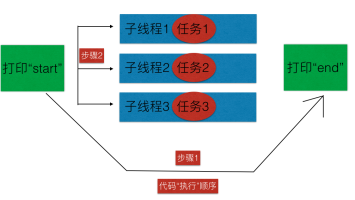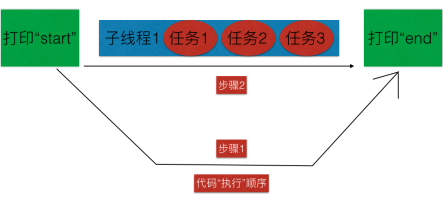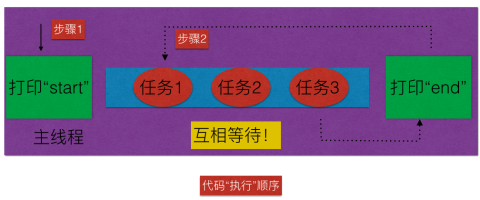线程、任务和队列的概念

异步、同步 & 并行、串行的特点

一条重要的准则
一般来说,我们使用GCD的最大目的是在新的线程中同时执行多个任务,这意味着我们需要两项条件:
-
能开启新的线程
-
任务可以同时执行
-
结合以上两个条件,也就等价“开启新线程的能力 + 任务同步执行的权利”,只有在满足能力与权利这两个条件的前提下,我们才可以在同时执行多个任务。
所有组合的特点

(一)异步执行 + 并行队列
实现代码:
|
1
2
3
4
5
6
7
8
9
10
11
12
13
14
15
16
17
18
19
20
|
//异步执行 + 并行队列- (void)asyncConcurrent{ //创建一个并行队列 dispatch_queue_t queue = dispatch_queue_create("标识符", DISPATCH_QUEUE_CONCURRENT); NSLog(@"---start---"); //使用异步函数封装三个任务 dispatch_async(queue, ^{ NSLog(@"任务1---%@", [NSThread currentThread]); }); dispatch_async(queue, ^{ NSLog(@"任务2---%@", [NSThread currentThread]); }); dispatch_async(queue, ^{ NSLog(@"任务3---%@", [NSThread currentThread]); }); NSLog(@"---end---");} |
打印结果:
|
1
2
3
4
5
|
---start--- ---end--- 任务3---{number = 5, name = (null)} 任务2---{number = 4, name = (null)} 任务1---{number = 3, name = (null)} |
解释
-
异步执行意味着
-
可以开启新的线程
-
任务可以先绕过不执行,回头再来执行
-
-
并行队列意味着
-
任务之间不需要排队,且具有同时被执行的“权利”
-
-
两者组合后的结果
-
开了三个新线程
-
函数在执行时,先打印了start和end,再回头执行这三个任务
-
这三个任务是同时执行的,没有先后,所以打印结果是“任务3-->任务2-->任务1”
-
步骤图

(二)异步执行 + 串行队列
实现代码:
|
1
2
3
4
5
6
7
8
9
10
11
12
13
14
15
16
17
18
|
//异步执行 + 串行队列- (void)asyncSerial{ //创建一个串行队列 dispatch_queue_t queue = dispatch_queue_create("标识符", DISPATCH_QUEUE_SERIAL); NSLog(@"---start---"); //使用异步函数封装三个任务 dispatch_async(queue, ^{ NSLog(@"任务1---%@", [NSThread currentThread]); }); dispatch_async(queue, ^{ NSLog(@"任务2---%@", [NSThread currentThread]); }); dispatch_async(queue, ^{ NSLog(@"任务3---%@", [NSThread currentThread]); }); NSLog(@"---end---");} |
打印结果:
|
1
2
3
4
5
|
---start--- ---end---任务1---{number = 3, name = (null)}任务2---{number = 3, name = (null)}任务3---{number = 3, name = (null)} |
解释
-
异步执行意味着
-
可以开启新的线程
-
任务可以先绕过不执行,回头再来执行
-
-
串行队列意味着
-
任务必须按添加进队列的顺序挨个执行
-
-
两者组合后的结果
-
开了一个新的子线程
-
函数在执行时,先打印了start和end,再回头执行这三个任务
-
这三个任务是按顺序执行的,所以打印结果是“任务1-->任务2-->任务3”
-
步骤图

(三)同步执行 + 并行队列
实现代码:
|
1
2
3
4
5
6
7
8
9
10
11
12
13
14
15
16
17
18
|
//同步执行 + 并行队列- (void)syncConcurrent{ //创建一个并行队列 dispatch_queue_t queue = dispatch_queue_create("标识符", DISPATCH_QUEUE_CONCURRENT); NSLog(@"---start---"); //使用同步函数封装三个任务 dispatch_sync(queue, ^{ NSLog(@"任务1---%@", [NSThread currentThread]); }); dispatch_sync(queue, ^{ NSLog(@"任务2---%@", [NSThread currentThread]); }); dispatch_sync(queue, ^{ NSLog(@"任务3---%@", [NSThread currentThread]); }); NSLog(@"---end---");} |
打印结果:
|
1
2
3
4
5
|
---start--- 任务1---{number = 1, name = main} 任务2---{number = 1, name = main} 任务3---{number = 1, name = main} ---end--- |
解释
-
同步执行执行意味着
-
不能开启新的线程
-
任务创建后必须执行完才能往下走
-
-
并行队列意味着
-
任务必须按添加进队列的顺序挨个执行
-
-
两者组合后的结果
-
所有任务都只能在主线程中执行
-
函数在执行时,必须按照代码的书写顺序一行一行地执行完才能继续
-
-
注意事项
-
在这里即便是并行队列,任务可以同时执行,但是由于只存在一个主线程,所以没法把任务分发到不同的线程去同步处理,其结果就是只能在主线程里按顺序挨个挨个执行了
-
步骤图

(四)同步执行+ 串行队列
实现代码:
|
1
2
3
4
5
6
7
8
9
10
11
12
13
14
15
16
17
|
- (void)syncSerial{ //创建一个串行队列 dispatch_queue_t queue = dispatch_queue_create("标识符", DISPATCH_QUEUE_SERIAL); NSLog(@"---start---"); //使用异步函数封装三个任务 dispatch_sync(queue, ^{ NSLog(@"任务1---%@", [NSThread currentThread]); }); dispatch_sync(queue, ^{ NSLog(@"任务2---%@", [NSThread currentThread]); }); dispatch_sync(queue, ^{ NSLog(@"任务3---%@", [NSThread currentThread]); }); NSLog(@"---end---");} |
打印结果:
|
1
2
3
4
5
|
---start--- 任务1---{number = 1, name = main} 任务2---{number = 1, name = main} 任务3---{number = 1, name = main} ---end--- |
解释
-
这里的执行原理和步骤图跟“同步执行+并发队列”是一样的,只要是同步执行就没法开启新的线程,所以多个任务之间也一样只能按顺序来执行,
(五)异步执行+主队列
实现代码:
|
1
2
3
4
5
6
7
8
9
10
11
12
13
14
15
16
17
|
- (void)asyncMain{ //获取主队列 dispatch_queue_t queue = dispatch_get_main_queue(); NSLog(@"---start---"); //使用异步函数封装三个任务 dispatch_async(queue, ^{ NSLog(@"任务1---%@", [NSThread currentThread]); }); dispatch_async(queue, ^{ NSLog(@"任务2---%@", [NSThread currentThread]); }); dispatch_async(queue, ^{ NSLog(@"任务3---%@", [NSThread currentThread]); }); NSLog(@"---end---");} |
打印结果:
|
1
2
3
4
5
|
---start--- ---end--- 任务1---{number = 1, name = main} 任务2---{number = 1, name = main} 任务3---{number = 1, name = main} |
解释
-
异步执行意味着
-
可以开启新的线程
-
任务可以先绕过不执行,回头再来执行
-
-
主队列跟串行队列的区别
-
队列中的任务一样要按顺序执行
-
主队列中的任务必须在主线程中执行,不允许在子线程中执行
-
-
以上条件组合后得出结果:
-
所有任务都可以先跳过,之后再来“按顺序”执行
-
步骤图

(六)同步执行+主队列(死锁)
实现代码:
|
1
2
3
4
5
6
7
8
9
10
11
12
13
14
15
16
17
|
- (void)syncMain{ //获取主队列 dispatch_queue_t queue = dispatch_get_main_queue(); NSLog(@"---start---"); //使用同步函数封装三个任务 dispatch_sync(queue, ^{ NSLog(@"任务1---%@", [NSThread currentThread]); }); dispatch_sync(queue, ^{ NSLog(@"任务2---%@", [NSThread currentThread]); }); dispatch_sync(queue, ^{ NSLog(@"任务3---%@", [NSThread currentThread]); }); NSLog(@"---end---");} |
打印结果:
|
1
|
---start--- |
解释
-
主队列中的任务必须按顺序挨个执行
-
任务1要等主线程有空的时候(即主队列中的所有任务执行完)才能执行
-
主线程要执行完“打印end”的任务后才有空
-
“任务1”和“打印end”两个任务互相等待,造成死锁
步骤图
